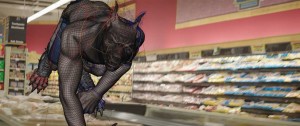
VFX supervisor Pete Dionne and Robert Winter, and VFX producer Doug Oddy led the team working on the film. Working closely with director Rob Letterman and production VFX supervisor Erik Nordby, the team’s work ranged from CG environments to magical effects, but the bulk of the work was focused on creating the movie’s monsters.
MPC created 17 different creatures including The Werewolf of Fever Swamp, The Abominable Snowman of Pasadena, an army of evil lawn Gnomes, the plant monster, a 50-foot Mantis, the Blob, Bug Eyed aliens and a Vampire Poodle. MPC’s in‐house art department in London created concept art for the Lawn Gnomes, the Plant Monster, the Blob, the Mantis and the Vampire Poodle.
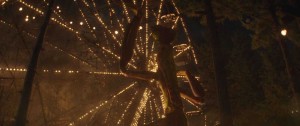 With so many monsters, a range of motion design for each character’s movement was required. For the bipedal monsters, a combination of motion capture and keyframe animation was used. Depending on the performance required, MPC’s artists took a hybrid approach, first capturing movement using MoCap suits and then hand‐animating over the top of the data to further elaborate and add nuances to the performance. The Werewolf and the Abominable Snowman both had unique facial proportions so their facial performance was completely keyframe animated.
With so many monsters, a range of motion design for each character’s movement was required. For the bipedal monsters, a combination of motion capture and keyframe animation was used. Depending on the performance required, MPC’s artists took a hybrid approach, first capturing movement using MoCap suits and then hand‐animating over the top of the data to further elaborate and add nuances to the performance. The Werewolf and the Abominable Snowman both had unique facial proportions so their facial performance was completely keyframe animated.
For the animation of the Lawn Gnomes, it was important to the director that the movement looked realistic and devoid of any deformation. This limitation complimented the mischievous personality of the characters. To justify this rigid style of motion, every time the Gnomes moved, their outer shells would crack and split at the joints, allowing for an increased range of motion. To achieve this across an entire army of gnomes, a method was designed to drive cracking in the rig, and then embellish the hero moments with additional FX simulations.
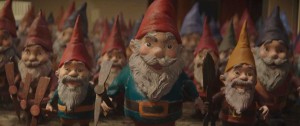 The most challenging creatures from a motion design standpoint were the Blob and the Plant Monster. Neither creature had any obvious real‐world references to start from and both had very dynamic forms, which ruled out traditional rigs. MPC’s animators used modular rigs that could be animated to block out the motion, in whatever form was required. This provided them with a base that gave the general motion of the performance, which was then used to drive extensive cloth and fluid dynamics to ultimately define the motion. The shading and lighting of the Blob also proved to be challenging due to the refractive nature of its texture, its ever-changing volume, and the wide range of lighting within the amusement park set. The lighting team had to carefully balance lighting and shading parameters on every single shot in order to maintain consistency throughout the sequence.
The most challenging creatures from a motion design standpoint were the Blob and the Plant Monster. Neither creature had any obvious real‐world references to start from and both had very dynamic forms, which ruled out traditional rigs. MPC’s animators used modular rigs that could be animated to block out the motion, in whatever form was required. This provided them with a base that gave the general motion of the performance, which was then used to drive extensive cloth and fluid dynamics to ultimately define the motion. The shading and lighting of the Blob also proved to be challenging due to the refractive nature of its texture, its ever-changing volume, and the wide range of lighting within the amusement park set. The lighting team had to carefully balance lighting and shading parameters on every single shot in order to maintain consistency throughout the sequence.
In the movie, the Goosebumps manuscripts serve as a portal for the monsters to travel between the realm of fiction and the real world, an event that occurs across several sequences. MPC was tasked with visually describing this story point, which grew into many different complex and unique FX events, depending on the creature, circumstance, and scale. The most prominent element of this effect was designed around the concept of the manuscript ink lifting from the page and forming the creatures. Supporting volumetric elements, airborne debris and snow, flashing lights and tornado‐like winds blowing the creatures’ fur and clothes all added to the chaos required for the scene.
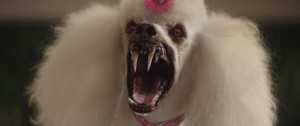 The final showdown between the heroes and the creatures occurs at an abandoned amusement park in the woods. MPC’s pre‐vis team was on set in Atlanta during pre‐ production planning of this major sequence. The team developed pre‐vis to assist with shooting of the complex Ferris wheel sequence and helped design the action and camera blocking. They were able to reverse engineer the camera and Ferris wheel motion into a single camera move against a static Ferris wheel carriage, which was then matched in the practical photography. Once the plates were match moved and the intended Ferris wheel motion was extrapolated from the camera motion, the plates of the actors dropped into the CG action.
The final showdown between the heroes and the creatures occurs at an abandoned amusement park in the woods. MPC’s pre‐vis team was on set in Atlanta during pre‐ production planning of this major sequence. The team developed pre‐vis to assist with shooting of the complex Ferris wheel sequence and helped design the action and camera blocking. They were able to reverse engineer the camera and Ferris wheel motion into a single camera move against a static Ferris wheel carriage, which was then matched in the practical photography. Once the plates were match moved and the intended Ferris wheel motion was extrapolated from the camera motion, the plates of the actors dropped into the CG action.
Though an elaborate set was built for these scenes, a large number of shots also took place above the forest canopy in and around an 80-foot tall Ferris wheel, which was shot on a greenscreen stage. A CG environment was built using a combination of fully rendered assets, 2.5D projections and digital matte paintings. MPC provided a wide range of backgrounds and extensions for the practical greenscreen shots, in addition to several full CG shots, including a sequence where the Ferris wheel detaches from its base and rolls through the forest, leaving a path of destruction behind.
Goosebumps In VR
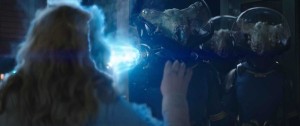 MPC also created a virtual reality experience enabling moviegoers to put themselves inside an action‐packed scene from the movie. The Goosebumps VR Adventure was featured in select theaters lobbies across the country.
MPC also created a virtual reality experience enabling moviegoers to put themselves inside an action‐packed scene from the movie. The Goosebumps VR Adventure was featured in select theaters lobbies across the country.
“VR is an intimate and immersive platform that transports the viewer into the space and story,” said MPC executive producer‐VR Tim Dillon. “In this way, our VR experience was perfect for Goosebumps. We place an audience member in the car, riding shotgun with Jack Black playing R.L. Stine, while Jack drives through town with a giant praying mantis chasing him down. The result is a virtual reality adventure attraction.”
The VR experience, directed by Letterman, was produced by MPC’s content production division, MPC Creative. This included everything from live‐action production through VFX and final grade. Motion systems technology company D‐Box provided the mechanical chairs for the VR experience, which move in sync what the viewer is seeing inside the headset. “The car chase scene is a great example of how technique meets the storytelling component of VR,” said Dan Marsh, creative director, MPC Creative, LA. “In the 360‐degree 3D VR Adventure, viewers can look around in all directions throughout the film, but they don’t have the control to walk around. Placing the viewer in the car, they can experience the scale of the scene and momentum of the chase. Jack Black, seated inches away from us, acts as a tour guide as the car flees from the monster. The D‐Box chair is the icing on the cake, because it situates people in the experience so they really feel the thrill of the chase.”
“VR shoots are a new frontier,” explained MPC Creative, LA, executive producer Mike Wigart. “The execution of the story required a unique creative solution. We were in the fortunate position of being able to utilize our VFX brainpower to test methodologies and techniques ahead of rolling cameras.”
Creating The Title Sequence
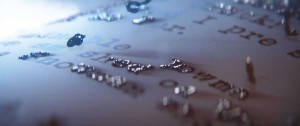 MPC Film’s Pete Dionne and Doug Oddy who suggested the studio enlist MPC for Goosebumps’ title sequence, putting them in touch with MPC Creative’s Wigart and creative director Eric Anderson.
MPC Film’s Pete Dionne and Doug Oddy who suggested the studio enlist MPC for Goosebumps’ title sequence, putting them in touch with MPC Creative’s Wigart and creative director Eric Anderson.
“We seized the opportunity to design the title sequence,” Wigart said. “Eric Anderson and his team created storyboards based on the book covers. Drawing from his history as an editor, Eric cut a fantastic animatic linking Goosebumps’ iconic book cover vignettes for a very engaging story. Every scene in the sequence had a clear reference based on the original book art, with the exception of the opening cover featuring Jack Black.”
The team enlisted the aid of New Jersey artist Tim Jacobus, who illustrated nearly the full series of R.L. Stine’s 100 books.
“An article came out in Vice this May about Tim Jacobus’s work on the original Goosebumps series,” Wigart related. “We read it and thought, ‘Why don’t we just have Tim do it?’ There was no better person in the world to create a piece of Goosebumps cover art than the original artist. So we reached out and commissioned him to create an original artwork in his trademark Goosebumps style. It was all very serendipitous.”
“The magical part of the title sequence was seeing a world of iconographic Goosebumps book covers come to life in its own self‐contained story,” said Anderson. “As we did with all of the effects, we approached the sequence in a way that it would pay off and look great in both 2D and 3D.”





